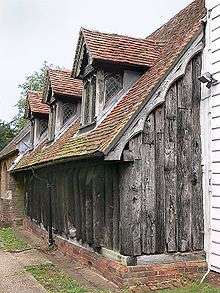Greensted Church
Greensted Church, in the small village of Greensted, near Chipping Ongar in Essex, England, is the oldest wooden church in the world,[1] and probably the oldest wooden building in Europe still standing, albeit only in part, since few sections of its original wooden structure remain. The oak walls are often classified as remnants of a palisade church or a kind of early stave church, dated either to the mid-9th[2] or mid-11th century.
The Grade I listed building lies about a mile west of Chipping Ongar town centre. Its full title is The Church of St Andrew, Greensted-juxta-Ongar. It is, however, commonly known simply as Greensted Church. Greensted is still a functioning church and holds services every week. The volume of tourist visits is light, but steady. The church was featured on a British postage stamp issued in 1972.[3]
History

Greensted Church has stood for nearly 1,200 years. Archaeological evidence suggests that, before there was a permanent structure, there may well have been another church, or a holy place, on the site for much longer, possibly dating back to around the 4th century.
Construction of the first permanent church on this site is thought to have begun shortly after St Cedd began his conversion of the East Saxon people around 654. The archaeological remnants of two simple wooden buildings were discovered under the present chancel floor, and these are thought to have been built in the late sixth or early 7th century.[4]
The church's dedication to St Andrew suggests a Celtic foundation for the original sanctuary. The body of King Edmund the Martyr of East Anglia (who was killed in 870, possibly at Hoxne) is said to have rested there in 1013, on its way to reburial at Bury St Edmunds.[5] There are many tributes to St Edmund in the church itself.
Construction

The church, like many, has had work performed on it over the centuries.
Anglo-Saxon and Norman elements
The nave is made of large split oak tree trunks, which was a traditional Saxon way of building. The nave is mostly original, and dendrochronological research in the 1960s dated it to 845. In 1995, however, this date was revised to 1053 +10–55 years (some time between 1063 and 1108).[6] This range of dates is based on the dendrochronological date of the youngest timber (1053), plus a standard allowance of 10–55 years for sapwood rings which are assumed to have been weathered away.
An interesting detail of the nave is the so-called "Leper's Squint" on the north side. This small aperture through the oak wall was formerly thought to have been a place where lepers who, not allowed inside the church with the general populace, were allowed to receive a blessing from the priest. Its position next to the original doorway has led researchers to conclude that it was a window used to see who was approaching the church.[7]
In the chancel, the flint footings of the wall and the pillar piscina inside the sanctuary are all that is left of any Norman work.
16th century
The original chancel was small and built of timber, but the current brick-built chancel dates from this period of construction.
17th to 19th century
The distinctive white weatherboarded tower was added in the Stuart period (17th century), and is what initially draws the eye. One of the bells is inscribed "William Land made me 1618", and so many consider the tower may in fact have been built earlier. This would not be too surprising as there are a number of mediaeval wooden towers in the district.
Around this time the three dormer windows were added to the nave for the first time, and the south porch was added. A fragment of 15th-century glass can be seen in the centre of the quatrefoil window at the west end, but it was set there during the Victorian restoration. The earliest wall memorial is dedicated to Jone Wood, 1585.
Victorian restoration
Reconstruction work by the Victorians in the 19th century added some detailed brickwork to the building along with, most probably, some of the more ornate decoration to the outside. Specifically it replaced the 3 dormer windows with 6, and the porch was also reconstructed, along with other minor alterations and stone coping.
Notable events
Near the porch, a large, coped stone marks the resting place of an unknown early crusader who is said to have arrived, badly wounded, at the church and died there.
Some of the Tolpuddle Martyrs were granted farm tenancies in the area after they returned from transportation and the record of marriage of one of them, James Brine, can be seen in the present register. Brine later moved to London, Ontario, Canada. He died in 1902 and is buried in St. Marys, Ontario.
Churchyard
The churchyard contains the war graves of three soldiers of World War I and an airman of World War II.[8]
References
- Frewins, Clive. The Church Explorer's Handbook. Canterbury Press Ltd, 2005. ISBN 1-85311-622-X. Page 16.
- Historic England. "Details from listed building database (1124095)". National Heritage List for England. Retrieved 2 June 2008.
- Stanley Gibbons Stamp Catalogue (1982), Part 1: British Commonwealth. London: Stanley Gibbons Publications Ltd., p GB 24.
- "History: Greensted church". Greensted Church. Retrieved 19 September 2018.
- Jennifer Westwood, Albion: a Guide to Legendary Britain, Book Club Associates (1986) ISBN 978-0881621280 (p.152)
- Tree-ring analysis of timbers from the stave church at Greensted, Essex, Ancient Monuments Laboratory Report 14/96 Archived 2016-05-08 at the Wayback Machine
- "Greensted Church – The Oldest Wooden Church in the World". Historic UK. Retrieved 19 September 2018.
- CWGC Cemetery Report. Breakdown obtained from casualty record.
External links
| Wikimedia Commons has media related to Greensted Church. |